The Hunt for Planet 9 reveals a strange new Kuiper Belt Object and 12 New Moons of Jupiter found
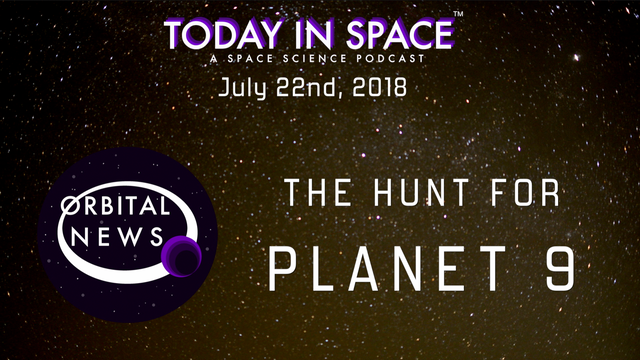
Hello Steemians!
As a newbie I'm still new to everyone so a quick introduction, if you don't mind. My name is Alex G. Orphanos, and I am a #science communicator. I graduated college with a degree in #Aerospace #Engineering, host a #space #science #podcast called 'Today In Space', and have my own 3D printing company called AG3D Printing. I'm still adjusting and growing into Steemit, it's been very inviting so far - so thank you!
I usually create my podcasts by doing research, writing the story, and then recording it to post on #Applepodcasts, #Youtube, and here on #Steemit now. But I never really post my transcripts, even though they are there. So, I wanted to try something different. I would love to hear any constructive feedback on how well this communicates science. Did you learn something? Did something stick out that was good/could be improved on/wasn't good? I went to school for engineering, my writing still needs some work but I hope the information comes through interesting and entertaining AND educational. Let me know how I did on each of those if you have a second of your day. Much appreciated.
Please enjoy this Orbital News Segment about the hunt for #Planet9, and the recent science discoveries that have come with it as of July 22nd, 2018.
Here is the video for anyone who wants to watch the episode. To #read, keep scrolling past the video.
TRANSCRIPT:
Hello and welcome to this episode of Orbital News, I am your science communicator Alex G. Orphanos and today in space we’ll be talking all about #Planet9, or #PlanetX, however you like it. I’ll refer to it as both throughout the episode. Although the prediction of a 9th planet is not new, there has been a-lot of buzz about Planet 9 recently and it was a good time to go over it all and share some of the recent news and discoveries around the hunt for Planet X that includes a new #KuiperBeltObject with a strange orbit and 12 moons around one of our largest planets.
Let’s begin.
WHAT IS PLANET NINE?
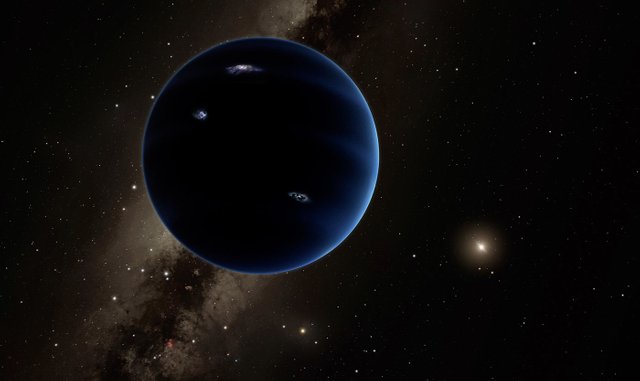
CREDIT: NASA
Planet 9 is the hypothetical planet introduced to explain a strange phenomenon with some of the most distant objects in the #KuiperBelt of our #solarsystem. This ‘Planet X’, is predicted to be 10 times the mass of Earth, and 5,000 times more massive than Pluto. It was predicted to exist after an announcement in January of 2015 by two #Caltech astronomers Konstantin Batygin and Mike Brown. Their new research and wild prediction was based on detailed mathematical modeling and computer simulations that essentially created a simulated solar system that included Planet 9. They have been testing this simulated solar system and trying to look for gaps or holes in their prediction. Basically, prove themselves wrong.
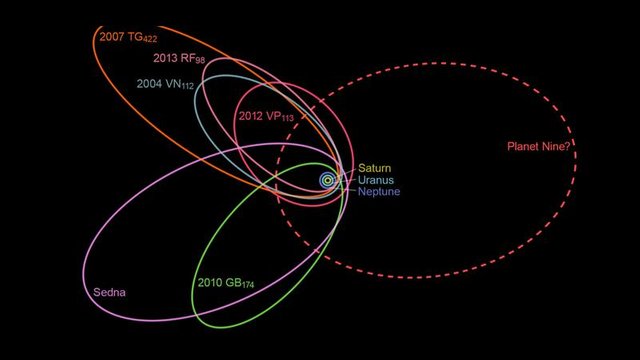
WHAT ABOUT PLUTO?
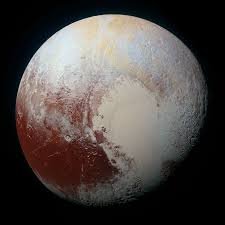
CREDIT: NASA
Now, we all know that #Pluto was originally the 9th planet, but after a reclassification in 2006 what we define a planet as changed. There are three criteria for an object in orbit to be classified as a #planet.
#1 The celestial body must be in orbit around it’s sun
#2 The planet itself must be round in shape
#3 The planet must have nothing in its path
Pluto had two of these criteria, but it’s orbit does have objects in its path, due to the chaos of the Kuiper Belt, it’s slightly tilted orbit, and it’s smaller size and gravitational influence.
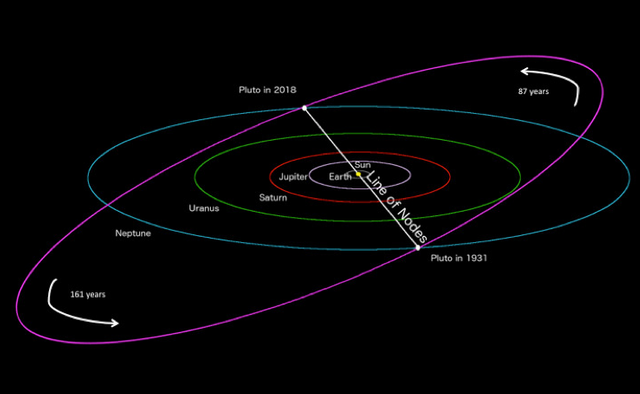
CREDIT: Anne Verbiscer
So if Planet 9 were to exist, it would have to pass all three of these classifications to be considered our 9th Planet.
In case you didn’t know, the person responsible for demoting Pluto, and who named themselves the Pluto Killer - is Mike Brown. Yes, the same Mike Brown predicting there is a Planet 9. Mike Brown may have killed Pluto but could also be responsible for giving us another planet in its place! If you’d like to follow Mike Brown on twitter, his hangle is @plutokiller.
WHAT IS THE KUIPER BELT?
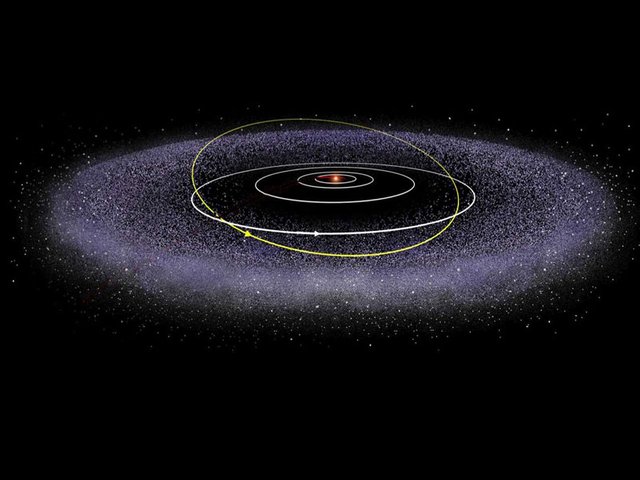
CREDIT: NASA
Let’s do a quick summary about the #KuiperBelt. Its the place where not only Pluto lives, but where an entire belt of objects reside in the deep dark of the third zone of our solar system. The Kuiper Belt is a doughnut-shaped ring of icy objects around the Sun, extending just beyond the orbit of Neptune from about 30 to 55 AU. It is similar to the asteroid belt, but is about 20 times wider and up to 200 times as massive. When the solar system first formed, it was filled with dust and debris, and some of that balled together to make our planets. Those planets picked up more debris while orbiting, and the rest eventually orbited into the sun or out of the solar system (or in the asteroid belt). Our 8 planets did a great job of cleaning out debris from the sun out to 30 AU. But the debris leftover remain orbiting out to 55 AU, which we call the Kuiper Belt.
The #NewHorizons #Spacecraft, responsible for the historic flyby of the Pluto system on its way to Kuiper Belt object 2014 MU69 and engaging in another historic flyby shortly after midnight Eastern Time January 1st 2019 - according to #NASA this KBO is “the most primitive and most distant object ever explored”...”a pristine building block of the solar system.”
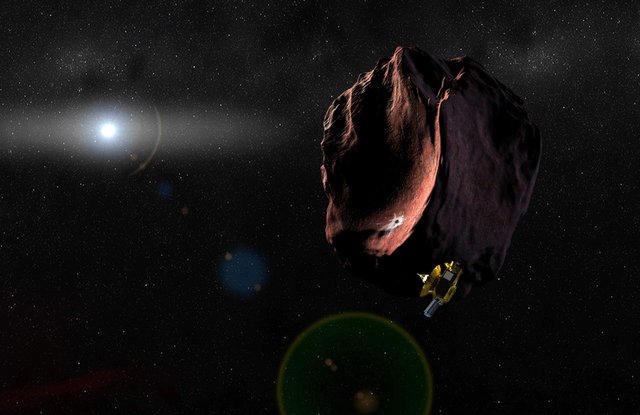
CREDIT: NASA, JHUAPL, SwRI, Alex Parker
NEWLY FOUND KUIPER BELT OBJECT’s ORBIT CAN BE EXPLAINED WITH PLANET 9
According to an article from QUANTA MAGAZINE
“#astronomers are reporting that they have spotted another distant world, perhaps as large as a #dwarfplanet, whose orbit is so odd that it is likely to have been shepherded by Planet 9”.
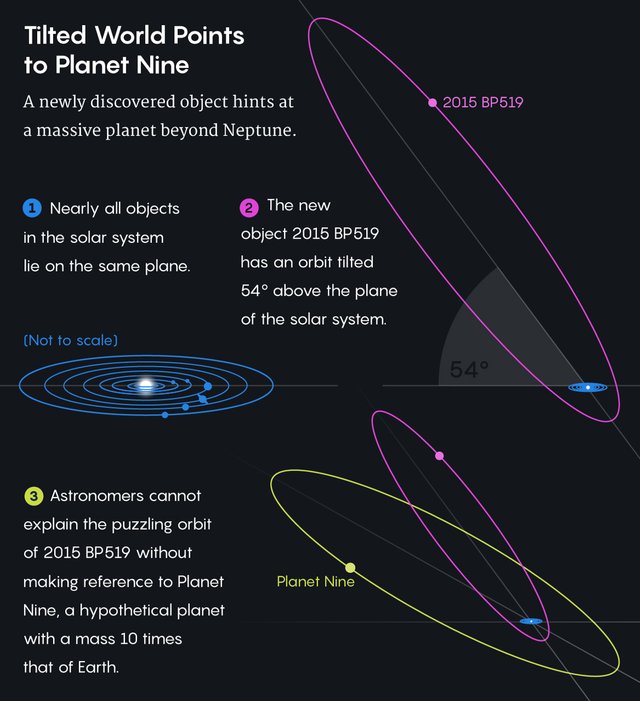
CREDIT: Lucy Reading-Iklanda/Quanta Magazine
This new discovery of object #2015BP519 has an orbital plane that is angled 54 degrees above nearly all the other objects in the solar system that orbit in the same plane. One of the only ways to explain this strange orbit is by having Planet 9 in the mix, balancing the orbit and making it stable so it doesn’t go into the sun or get launched out into deep space. This object was discovered by the #DarkEnergy Survey, which is a project that “probes the acceleration in the expansion of the universe by surveying a region well above the plane of the solar system”, which is why they were able to discover the object in the first place. Had Mike Brown and Konstantine Batygin not made the prediction of Planet 9’s strange angled orbit, David Gerdes and the Dark Energy Survey team may have never looked there.
One of the things that Mike Brown and Konstantin predicted was that Planet 9 would slowly push objects away from the solar system that don’t lie in the orbital plane like the rest of the objects, or in other words, the orbit has a significant inclination. That’s due to Planet 9 probably orbiting at a slight inclination as well. So over time, it is the nature of that orbit and a massive Planet 9 to push anything out of the orbital plane further away.
Since the Dark energy survey first discovered the new object 2015 BP519, they have been trying to explain the strange 54 degree inclination in its orbit by running simulations of the solar system forward and backward 4.5 billion years. There seemed to be no way that an object like this could be orbiting how it is. But, when they added the same characteristics Mike and Konstantine predicted for Planet 9 into the mix, everything lined up. Juliette Becker, a graduate student at Michigan and the lead author on the new paper about this object, said “The second you put Planet Nine in the simulations, not only can you form objects like this object, but you absolutely do,”
It fit so well that in the simulations that Mike and Constantine have made of an inclusionary planet 9 solar system, it fits so well it’s almost as if it’s a data point in their simulation. To quote Mike Brown,“A good theory reproduces data — but a great theory predicts new data,”
And according to Konstantine, “There is no other reasonable way to populate the Kuiper belt with such highly inclined bodies,” Batygin said. “I think the case for the existence of Planet Nine is now genuinely excellent.”
12 NEW MOONS FOUND IN THE HUNT FOR PLANET 9
But discoveries don’t stop there, there have been 12 new moons of #Jupiter found in the hunt for planet nine.
9 of those 12 moons are located farther out than the classical (and visible) Galilean Moons. These moons are also orbiting in retrograde, which means that the moons are orbiting the opposite direction that Jupiter is rotating.. There are two other moons orbiting closer to the Galilean #moons in prograde orbits, meaning they rotate with the planet. But, there is a rogue moon, currently named #Valetudo, that is in prograde orbit amongst the retrograde group of moons.
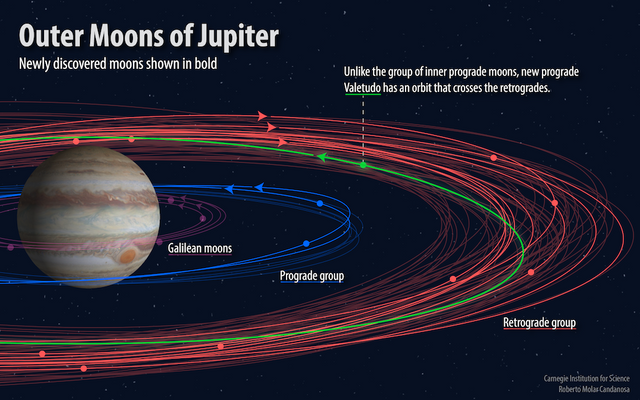
This is, as the article from smithsonianmag dot com states, is like driving down the highway on the wrong side of the road. Eventually, this rogue prograde moon named after the Roman god of health and hygiene will impact one or more of these moons. This type of head on collision, according to the article is likely by still relatively rare, as it occurs every billion years or so. But, the impact would be possible to view from Earth, according to the researchers. There doesn’t seem to be any consensus on when these new moons were created, but it's believed to have come from other moon impacting each other, as well as #asteroids impacting and then orbiting their pieces around Jupiter. So we’ll have to keep observing to see if we’re on the lucky side of that billion year impact.
Each of these moons are no larger than 2 miles or so in diameter. To compare these with the Galilean moons they are very small, since one of the Galilean moons, #Ganymede is about the same size as #Mercury. The retrograde outer moons and Valetudo take 2 #Earth years to complete one orbit around Jupiter while the inner prograde pair of moons orbit every Earth year. Valetudo is about ⅔ of a mile in diameter, which you would think is pretty small for a moon. But currently, there isn’t a clear definition of what a Moon is, which technically means any dust particle orbiting a planet could be considered a moon right now. But since the technology to inspect every single dust particle at Jupiter for its size and accurate orbit doesnt exist, it’s hard to adjust for this. It’s the same kind of issue there is with defining planets, which of course is what made the whole Pluto Killer thing a problem for most people.
But, in the meantime, we wait until we find more exciting discoveries to help us better understand the #universe around us. Discoveries like Planet 9, object 2015 BP519, and Valetudo among the 12 new moons found around Jupiter - all of these happened because we as humans looked at the information in front of us and asked why? Whether you’re searching for dark energy to explain the peculiar expansion of the universe, trying to find a ninth Planet to explain the unexplained nature of our most distant Kuiper Belt objects, or simply trying to figure out the world in front of you - science can help you sift through what seems to be impossible or unexplainable and gather data that may change the way we look at the universe around us. Science can be your guide through the unknown.
I hope you enjoyed this episode of Orbital News. Don’t forget to subscribe to the podcast on #Applepodcasts and #Youtube. You can find all the links for the topics we discussed today in the video description or on our website at todayinspace.net.
If you are a Pluto-lover, check out our song called “Pluto, the Misunderstood” an electronic science song about the demotion of Pluto, and the strange connection humans had to a planet they never actually new before New Horizon’s historic flyby gave us our first incredible views of this now dwarf planetary system. It’s available to purchase on #iTunes, is #streaming on #Spotify, and can be listened to for free on #soundcloud. You can find these links in this episodes description as well.
I am your science communicator Alex G. Orphanos, I hope you have a great week and make sure to as always, spread love and spread science.